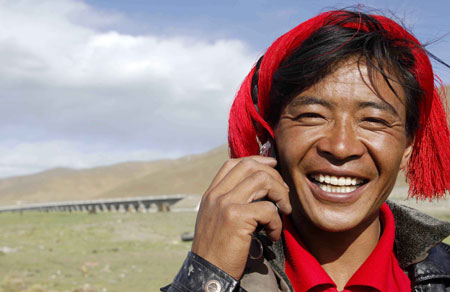Many people are straining to learn what's going on in Lhasa and other Tibetan-inhabited regions in western China almost a year after the violence that shocked the world.
As the first anniversary of March 14 Lhasa riots approaches, the government has made it a priority to maintain stability in Tibet and prevent a repeat of such a tragic history.
 |
|
A girl of the Tibetan ethnic group picks fruits in Nyingchi, southwest China's Tibet Autonomous Region, July 9, 2008.(Xinhua/Purbu Zhaxi) |
In so doing, the government and the ruling Communist Party of China are putting the livelihoods and interests of the Tibetan people above all else.
In the riots last year, innocent civilians suffered the most.
Tibetan businessman Losang still keeps photos of the damage to his souvenir store near Lhasa's Jokhang Temple. "They broke the glass and took away some of my most valuable items."
Losang feels easier seeing police and soldiers of the People's Liberation Army patrolling Lhasa's streets. "Tightened security is a good thing for business people and all residents."
"Who cares what other people think of the tightened security in Lhasa?" said a Tibetan woman who was taking her preschool daughter for a walk in a park near the Potala Palace.
"It's always easy to point a finger at others, but we are the ones who actually went through the tragic experience last year," she said. "If not for the police and PLA, I wouldn't have dared to take my daughter out to the streets now."
Her four-year-old daughter, Tenzin Tsepel, recalls nothing of the violence. "Fortunately she was too young to remember anything. Otherwise, it could have traumatized her."
Like all parents, the lady hopes her child can grow up in an environment free of violence and fear.
Is it not crucial for the central government to take action to maintain social stability in Tibet, to protect the innocent from harm?
Social stability is undoubtedly crucial in promoting Tibet's development and ultimately, improving the average Tibetan's quality of life. No matter how hard some people have tried to maintain the status quo and leave the plateau region a stereotyped cultural specimen for them to enjoy, the trend of modernization and betterment of people's lives is irreversible.
Fifty years after feudal serfdom in Tibet was abolished, the central government has built roads, schools and hospitals in Tibet to shorten the distance between Tibet and the inland regions. The average life expectancy of Tibetans has nearly doubled to 67.
Today, Tibetans are free to perform their religious rituals while enjoying the convenience brought by new technologies. Most Tibetan Buddhists bring their cell phones, alongside prayer wheels and yak butter, on their pilgrimages.
This would be impossible without social stability.
 |
|
A herdsman of the Tibetan ethnic group talks on the mobile phone in northern Tibet Autonomous Region June 26, 2008.(Xinhua/Purbu Zhaxi) |
The 14th Dalai Lama has been trying to tell the world that under him, Tibetans lived contentedly in a spiritual non-violent culture. But history shows the old Tibet was a feudal society darker than medieval Europe.
In addition, maintaining stability in Tibet is crucial in safeguarding China's sovereignty and territorial integrity, which is under threat unless the Dalai Lama and his supporters abroad give up their secessionist activities.
Any other government in the world would be on alert, too, had they been in China's shoes.
(Xinhua correspondents Hu Xing and Yan Yuanyuan contributed to this story.)

